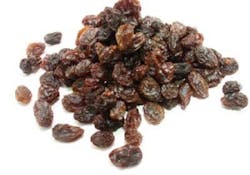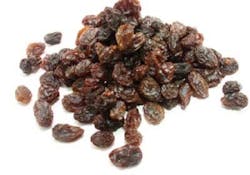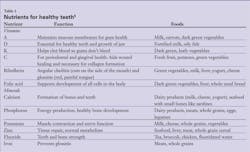Here come the raisins
An emphasis on raisin consumption for controlling dental caries
by Stacey Bell, DSc
Nutrition is an integral part of oral health. The focus of this article is to present a healthy diet, one that emphasizes raisins. The primary public health measures for reducing caries risk, from a nutritional perspective, are the consumption of a balanced diet by following the Food Guide Pyramid, and, from a dental perspective, using topical fluorides and consumption of fluoridated water.
Consumption of a poor diet, particularly one rich in sugary foods, can cause dental caries despite fluoridation. What constitutes a healthy diet that augments good dental hygiene? Most carbohydrate-containing foods precipitate the formation of caries, and those that adhere to the teeth (i.e., sticky) are thought to be the worst offenders. Paradoxically, raisins possess both of these characteristics, but do not induce dental caries. In addition, they contain a good source of nutrients, so that using them as one serving of fruit per day or as a healthy, low-fat snack is desirable and does not increase the risk of dental caries. Dental hygienists should recommend that patients eat a healthy diet, and now can suggest raisins be included to count as one of the servings of fruit needed each day.
Despite the use of fluoride in toothpaste and public water systems, the two most prevalent oral infectious diseases are dental caries and periodontal disease.1 Nutrition is an integral part of oral health and operates in a two-way system. Diet has a local effect on oral health, primarily on the integrity of the teeth, pH, and composition of saliva and plaque. Nutrition has a systemic effect on the integrity of the oral cavity, including teeth, periodontium, oral mucosa, and alveolar bone.1
Certain foods like those that are sticky may have a heightened cariogenic capacity, because of the increased exposure of the tooth to demineralization.2
As early as 1938, a relationship was observed between tooth decay and diet.3 Dr. Bion R. East summarized the known science of his time.3 Most of the work was conducted on institutionalized children, because their dietary intake could be controlled. First, Dr. East concluded that a healthy diet – containing milk, green vegetables, and fruits – reduced the risk of dental caries. Second, he found that vitamin D added to milk or obtained from cod liver oil, which was customary at the time, also reduced this risk. He outlined a simple, daily diet for healthy children, which arrested caries formation: one quart of milk, one egg, one ounce of butter, one teaspoonful of cod liver oil (for vitamin D, but now one quart of milk per day would provide adequate vitamin D), two vegetables (one being raw), and fresh fruits.
This simple diet plan is similar to what is proposed today in the U.S. Department of Agriculture Food Pyramid.4 Today it is known that children aged 2 to 5 years who had the best dietary practices were 44% less likely to exhibit severe early childhood caries (ECC) compared to those consuming a poorer diet.6 The children with the best teeth, compared to those in the worse group, ate more fruit, dairy products, and grains. Fruits were singled out as being particularly effective at interfering with plaque formation, because they reduce the production of acids from oral bacteria. It is thought that the high polyphenol and fiber in fruits is the reason for the unique benefit. Eating a healthy diet also provides teeth the necessary nutrients to maintain their strength (Table 1).
Impact of nutrition on oral health
The most common recommendation to maintain healthy teeth is to reduce the intake of sugar and other fermentable carbohydrates.1 These substances, after being hydrolyzed by salivary amylase, provide substrate for the actions of oral bacteria, which in turn lower plaque and salivary pH. This results in the beginning of tooth demineralization. It is best to consume sugar and other fermentable carbohydrates with meals, or as snacks in conjunction with protein such as cheese or milk to reduce the risk of this adverse effect.
Some researchers have questioned the cariogenic harm of sugar. In a 2009 review of the evidence, only six of 200 articles showed a strong relationship between sugar quantity consumed and dental caries.7 However, more studies (19) showed a relationship between sugar frequency consumption and dental caries formation. Others have reported that trying to determine the amount of sugar children consume is quite difficult, and this could explain these unusual findings.8 Regardless, sugar contains no essential nutrients, except calories, and therefore should be limited for health reasons and weight management.
Chewing sugarless gum that contains xylitol and sorbitol after meals or snacks for 15 to 20 minutes may reduce dental caries formation.9 If a pregnant woman chews xylitol-containing gum, she can delay the inevitable transmission of S. mutans to her baby by nearly nine months. This is long enough to be of benefit to prevent tooth decay in very young children.
Raisins: Are they cariogenic?
The American Dental Association advises consumers to avoid sticky, clingy foods rich in carbohydrates, because they pose an increased risk of dental caries.2 Raisins were thought to cause dental caries, because they possess both of these properties.
Most retained food particles serve as reservoirs of fermentable carbohydrates, thereby permitting plaque-forming microorganisms to continually produce acid and prolong the cariogenic challenge to the teeth. A research group at the Forsyth Institute in Boston asked consumers to rate the stickiness of 21 foods to see if they could figure out which foods to avoid. These ratings were then compared to actual stickiness, using standardized methodology, which measured the retention time of food on a tooth.
Consumer perception was that caramels, jelly beans, and filled chocolates were considered most sticky. Apples were thought to be the least; many of the other foods in the middle range of stickiness were ranked very close to each other. These included dried figs, milk chocolate bars, raisins, granola bars, cream sandwich cookies, cream-filled sponge cake, and oatmeal cookies.
Specifically, raisins ranked ninth of the 21 foods. Paradoxically, those rated as most sticky (caramels and jelly beans) were among those least retained. Instead, some perceived as low stickiness – potato chips, salted crackers, and sugared cereal flakes – had longer retention times. Although raisins were perceived to be as sticky as granola bars, cream sandwich cookies, and oatmeal cookies, they had only 14% as much retention as these other foods.
These data emphasize that consumers do not have adequate knowledge to determine which foods are sticky and should be avoided.
The impact of raisins on dental caries formation has been the focus of intense investigation. It seems logical that raisins would be a good choice because they were deemed to be less sticky than many other foods.2 Raisins are a healthy food to include with a meal or use as a snack, because they are low-fat, high-fiber, and contain the same healthy polyphenols as grapes.
Dr. Christine Wu and her colleagues at the University of Illinois College of Dentistry set out to determine the cariogenic effects of raisins in a series of experiments.10-13 Changes in plaque pH in response to eating raisins and foods containing them was determined.10 A pH of 5.5 to 5.7 renders the enamel at risk for acid attacks and caries formation. In this study, 19 adolescents (this age was chosen as they develop the most dental caries of any age group) ate 10 grams (about 1/3 of an ounce) of raisins from Thompson Seedless Grapes, the same amount of bran cereal with and without raisins, and a raisin bran cereal with sugar added. Sugar (sucrose) and sorbitol were used as controls. All dietary interventions lowered plaque pH except sorbitol, as expected as it has no known cariogenic effects. The reduced plaque pH peaked at 15 minutes, and returned to the pre-test pH by 30 minutes for all foods except sucrose. The food that lowered the pH the most was the bran cereal with raisins and added sugar. Thus, raisins on their own, or added to bran cereal, were better for the teeth than sucrose or raisin bran cereal with added sugar.
A second group of younger children (7-11 years of age) consumed the same diets.11 Ten minutes after raisins were consumed, the pH dropped, but recovered after 30 minutes. The results were similar to the adolescents. Even though raisins contained the highest sugar content of all foods tested (68% sugar), they were less acidogenic than bran cereal with raisins and added sugar. When raisins were added to bran, the acidity was lower than bran flakes alone, suggesting that raisins help enhance clearance of chewed bran particles from the teeth.
These studies dispel the myth that all sticky foods are cariogenic, and that raisins may, in fact, act as cleaners of teeth such as apples and bananas.
The same investigators determined how the raisins were able to protect the teeth by reducing the time of acidic exposure.12 An ethanol extract of Thompson Seedless raisins (Vitis vinifera L.) was prepared. The ability to suppress cariogenic bacteria strains – S. mutans, Porphyromonas gingivalis, and Fusobacterium nucleatum – was assessed. The raisin extract was able to suppress growth of the first two organisms and reduce adherence to a biofilm of the third.
From this study, it appears that raisins, because they contain natural phytochemicals, may contribute to oral health by suppressing growth of selected bacteria or by interfering with adherence of cariogenic bacteria. One phytochemical found in raisins, oleanolic acid, appeared to be the most virulent antibacterial agent against S. mutans and P. gingivalis.13
Another group of dental researchers at Paffenbarger Research Center in Gaithersburg, Md., looked at the demineralizing effect of raisins in a well-established in vitro model.14 In brief, the model uses human molars, which have a section of the outer enamel exposed. The teeth were incubated with S. mutans and a variety of test substances including a saliva-like solution (negative control), brain-heart infusion broth (positive system control), milk, orange juice, and a raisin extract. Teeth were bathed on and off with bacteria and test solutions to mimic the oral environment in the mouth. Over the next seven days, X-ray microradiographs of the teeth were assessed. The least to the most demineralization was: brain-heart broth infusion < milk < saliva-like solution < raisin extract < orange juice. Compared to the negative control, raisins were more cariogenic as they exhibited a lower pH around the tooth, but the results were not significant.
Milk had less demineralization activity compared to raisins and orange juice.14 This was probably because it is rich in calcium and phosphorus, which is similar to the makeup of a tooth, and low in sugar. Both raisins and orange juice are acidic (3.6-3.9 and 3.5, respectively) and are nearly devoid of calcium and phosphorus (except for calcium-fortified orange juice); it is unlikely that they could perform as well as milk. However, despite the pH of orange juice and raisins being similar, raisins outperformed the orange juice. This was thought to be due to the unique polyphenol makeup. In addition, orange juice contains citric acid, which is a particularly strong calcium chelator and can dissolve a tooth more rapidly than other foods like raisins, which do not contain it.
Based on the totality of the evidence, raisins appear to have only a minimal cariogenic effect and are safe to be included in the diet of children and adults. In addition, the nutritional composition of raisins makes them a healthy choice as a serving of fruit or to be consumed as a snack (see Table 2). Raisins are low in fat and calories, fiber-rich, low in sodium and high in potassium, and have a sweet, satisfying flavor.
Dental caries continue to be a major public health problem in the United States throughout the life span. They are formed from carbohydrate-rich foods, in particular sucrose, and those that are sticky. Even though raisins are perceived to be cariogenic, new research showed that they are rapidly cleared from the teeth, much like other fruits. In addition, despite having a sweet flavor, they are less cariogenic than sugar-coated raisin bran cereal and orange juice. This may be due to the unique blend of polyphenols and their ability to be cleared from the teeth rapidly. Raisins should be considered as a healthy, low-fat food to be eaten with meals or as a snack, as the previous concerns of their cariogenic effects have been refuted.
Nutrition is an integral component of oral health, but dentists, dental hygienists, and dental assistants often fail to discuss its importance with their patients. This review provided information on how to eat a healthy diet for optimal oral health. New information on raisins was also provided, which showed that they do not cause dental caries. Raisins are sweet and typically well-liked by children and adults. Hence, they can be recommended to patients without risking harm to the teeth.
Table 2
Nutritional composition of raisins (Vitis vinifera)15
Nutrients in one small box (1.5 oz.; 42 g)
Calories: 129
Protein (g): 1.32
Fat (g): 0.20
Carbohydrate (g): 34.05
Total dietary fiber (g): 1.6
Sucrose (g): 0.19
Glucose (dextrose) (g): 11.93
Fructose (g): 12.76
Sodium (mg): 5
Potassium (mg): 322
Stacey Bell, DSc, has been a registered dietitian for 35 years, and has worked in that capacity and conducted clinical research studies for 20 years. She received a doctorate in nutrition from Boston University, with Honors in 1994. She was on the faculty at Harvard Medical School in Boston, and has published over 70 peer-reviewed scientific articles. Her research interests include obesity, diabetes, cancer, AIDS, burn patients, and critical illness. She is a frequent lecturer around the world on many topics related to nutrition and has six issued patents. She presently serves on the board of a nonprofit agency, Kids Can Cook. The program offers basic cooking instruction and nutrition education to Boston middle-school-aged children. She can be contacted at (617) 999-6150 or [email protected]">href="mailto:[email protected]">[email protected].
References
1 Touger-Decker R, van Loveren C. Sugars and dental caries. Am J Clin Nutr 2003; 78(suppl):881S-892S.
2 Kashket S, Van Houte J, Lopez LR, Stocks S. Lack of correlation between food retention on the human dentition and consumer perception. J Dent Res 1991; 70:1314-1319.
3 East BR. Nutrition and dental caries. Am J Public Health 1938; 28:72-76.
4 http://www.MyPryramid.gov">www.MyPryramid.gov, accessed 2/2/10.
5 http://dentalsource.org/topic44nutrition.htm, accessed 1/29/10.
6 Nunn ME, Braunstein NS, Kaye EAK, Dietrich T, Garcia RI, Henshaw MM. Healthy eating index is a predictor of early childhood caries. J Dent Res 2009; 88:361-366.
7 Anderson CA, Curzon ME, Van Loveren C, Tatsi C, Duggal MS. Sucrose and dental caries: a review of the evidence. Obes Rev 2009; 10 Suppl:41-45.
8 Burt BA, Eklund SA, Morgan KJ, Larkin FE, Guire KE, Brown LO, Weintraub JA. The effects of sugars intake and frequency of ingestion on dental caries increment in a three-year longitudinal study. J Dent Res 1988; 67:1422-1429.
9 Nakai Y, Shinga-Ishihara C, Kaji M, Moriya K, Murakami-Yamanaka K, Takimura M. Xylitol gum and maternal transmission of mutans streptococci. J Dent Res 2010; 89:56-60.
10 La Monte D, Fadavi S, Koerber A, Wu CD. Effects of raisin-containing cereals on acidogenicity of dental plaque. International Assoc Dental Res and the Amer Assoc Dental Res, March 10-14, Honolulu, HW, abstract.
11 Utreja A, Lingstrom P, Salzmann L, Evans C, Wu CD. Raisins and cereals containing raisins on plaque acidogenicity in children. AADR-Chicago section meeting, April, 2008, abstract.
12 Wu CD, Zhu M, Su B-N, Workman JT, Kinghorn AD. Phytochemicals in raisins inhibit growth and adherence of plaque bacteria. Intern Assoc Dental Res annual meeting, Guthenburg, Sweden, June 2003, abstract.
13 Rivero-Cruz JF, Zhu M, Su B, Kinghorn AD, Wu CD. Antimicrobial constituents of Thompson Seedless Raisins (Vitis vinifera L.) against selected oral pathogens. Intern Congress on Natural Products Res, July 31-August 4, 2004, abstract.
14 Rose JL, Hoffman KM, Schmuck BD, Dickens SH, Carey CM. Raisins effects on in vitro demineralization of human teeth. Personal communication, April 2008.
15 http://www.nal.usda.gov/fnic/foodcomp/cgi-bin/list_nut_edit.pl">www.nal.usda.gov/fnic/foodcomp/cgi-bin/list_nut_edit.pl; accessed 2/7/10.
Past RDH Issues


